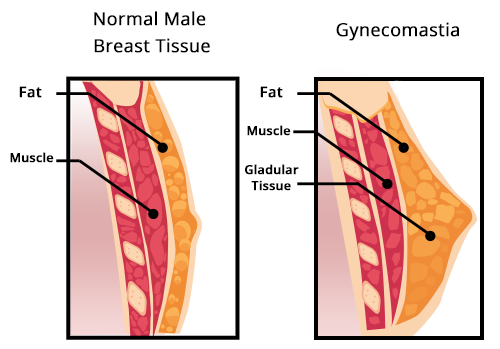Male Breast Reduction (Gynecomastia)
Gynecomastia is a condition that can occur in men of any age. Combining the Greek “gyne” meaning woman and mastia meaning “breast,” gynecomastia is characterized by excess breast tissue in males. The enlarged breast tissue can be caused by increased, firmer, glandular tissue or excess, softer, fat (adipose) tissue or a combination of the two. The excess breast tissue can affect one or both breasts from adolescent boys to adult males. It results from genetic predisposition, obesity, use of certain medications or hormonal fluctuations. The condition can be uncomfortable both physically and mentally, potentially leading to withdrawal from normal everyday activities and intimate situations.
Men who are good candidates for gynecomastia surgery:
- Feel that their breasts are too large.
- Are healthy and of average and stable weight.
- Cannot utilize alternative medical therapies to relieve the condition.
- Have no additional medical conditions or a serious illness that would prevent healing.
- Have stabilized breast growth.
Teen boys may also be considered for this surgery, but it may be necessary for additional future procedures if breast tissues continue to develop.
Surgery & Anesthesia
Surgical treatment, male reduction mammoplasty, is an option for this condition. Gynecomastia surgery flattens the chest by reducing the breast size and improving chest contour. If the breast tissue is excessively heavy, the areola (dark skin around the nipple) may sag. In this case, the location and size of the areola can be adjusted as needed. Physical examination can distinguish if breast enlargement is due to the firmer glandular tissue or softer fatty tissue or a combination of the two.
When gynecomastia is the result of too much fatty tissue, liposuction may be the only technique required. A narrow cannula is used to suction the excess fat. If excess skin or glandular breast tissues are to be removed to correct the gynecomastia, an excision technique will be utilized. This process is required if adjustments must be made to the areola. Sometimes, a combination of both liposuction and excision techniques are used to correct gynecomastia.
The type of anesthesia used during your procedure depends on the extent of surgery. At Bel-Red Ambulatory Surgical Facility, Dr. Zemplenyi can perform the gynecomastia surgery under “twilight sleep” sedation or general anesthesia, depending on patient need and safety.
Postoperative Care
Postoperative Care following gynecomastia surgery is straightforward. Soreness and sensitivity in the chest, as well as bruising and swelling are common for several days after the procedure. Light activity may be resumed after several days with normal responsibilities undertaken in a couple of weeks. Restrictions may include no heavy lifting for several weeks and strenuous abdominal and back exercises resumed after about a month. Recovery time is highly individualized and will be discussed at length after surgery.
Frequently Asked Questions
- What can I do to prepare for gynecomastia surgery?
- Ceasing smoking as far in advance as possible before the procedure will encourage healing. It is also necessary to stop aspirin, some herbal supplements, Vitamin E and anti-inflammatory medication to reduce the chance for post-operative bleeding. A baseline mammogram is often recommended, as well. Detailed instructions will be provided to aid you in preparing for surgery. Someone will need to drive you from the surgery and remain with you overnight after it is completed.
- What type of anesthesia is used for gynecomastia surgery?
- You and your surgeon will discuss whether intravenous sedation or general anesthesia will provide you the most safety and comfort.
- What kind of surgical technique is used to remove excess breast tissue in gynecomastia?
- The type of surgery used in gynecomastia reduction depends upon breast size, type of tissue and how much tissue must be removed. If fatty tissue is responsible for the problem, liposuction is often enough. If glandular tissue must be removed, an incision is made to remove the firm glandular tissue. When excess skin is involved, incisions are made near the areolas, either vertically or horizontally to the breast crease. The nipple and areola may need to be moved upward for a more traditional position after removal of breast tissue.
- What are the postoperative instructions?
- Normal activities may be resumed in about two weeks but energetic exercise and heavy lifting should not be attempted for about three to four weeks.
- Are there risks associated with gynecomastia surgery?
- All surgical procedures carry some risks. These include infection, bleeding, blood clots and adverse reaction to anesthesia. Breast surgery may lead to loss of feeling in the nipples or breasts. There may be need for revision surgery, asymmetrical breasts or nipples or scars. Consequences of the surgery will be discussed during your consultation.
- What is the cost for gynecomastia surgery?
- Gynecomastia surgery costs are dependent upon the kind of procedure and how long it takes. You will be given an estimate during the consultation



I had such a positive experience here with Dr. Z and his staff. From the initial consultation to my post-surgery appts. I couldn't have asked for a better experience. All my questions/concerns were addressed, the surgery itself went really well (and I am so happy with my results, seriously life changing), my recovery went smoothly and Dr. Z gave me his personal cell # so I could reach out if I had any worries during my recovery. Dr. Z and his staff truly care about their patients and go above and beyond to deliver the best results! I highly recommend coming here if you need any aesthetic surgery, you won't be disappointed.